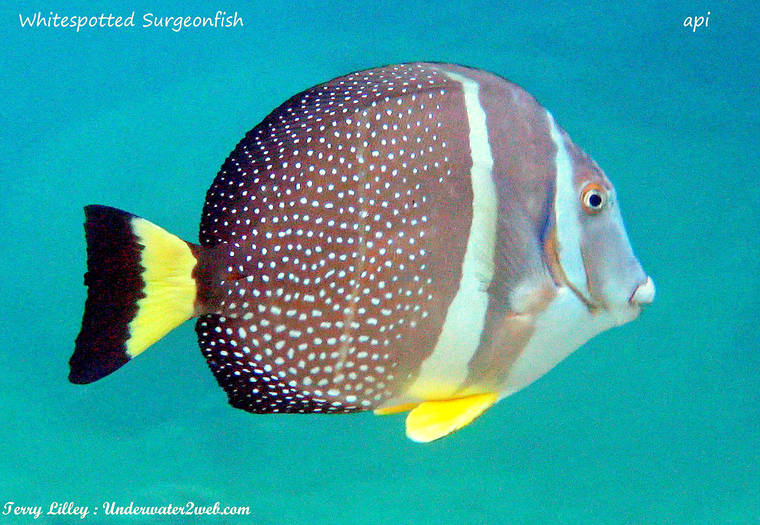This common foot-long Hawaiian reef fish is often missed by people who snorkel and scuba dive because they live right in the surf, where it is not safe to dive! In order to see them you have to go out beyond the waves and safely look back to shore where they will flow in and out of the reef with the surge from the surf.
This common foot-long Hawaiian reef fish is often missed by people who snorkel and scuba dive because they live right in the surf, where it is not safe to dive! In order to see them you have to go out beyond the waves and safely look back to shore where they will flow in and out of the reef with the surge from the surf.
Why do fish have spots? To blend into their background so they are not seen by predators and api blends right in with the bubbles in the surf. These beautiful fish zoom around in small schools eating algae off of the lava rocks right in the crashing waves.
You often see them in the middle of larger schools of convict tangs. This way, if a larger predator fish tries to eat them they blend into the larger school of fish and are hard to see due to all of the bubbles from the surf.
Api are a type of surgeonfish so they have a sharp spine at the base of their tail that can cause a severe cut on your hand if you try to grab one. They are an important part of the reef ecosystem as they keep the reef clean by eating the algae which then gives room for the shallow water corals to grow.
Api are extremely difficult to get a good picture of because they are super fast swimmers, change directions instantly, blend into the bubbles from the surf and also are the same yellow and brown colors of the reef and corals. This picture I got lucky as one of them was crossing across deep blue water to get from one shallow reef to the next to join a large school of fish!
You can see api in action in my video the Worlds Guide To Hawaiian Reef Fish up on my underwater educational web page at www.underwater2web.com and also follow my daily marine life Instagram post at terry.lilley
Aloha from under the surf.
•••
Terry Lilley, marine biologist, Hanalei, underwater2web.com, www.gofundme.com/5urrm4zw, All Photographs © 2016 Terry Lilly

Subscribe today for unlimited access.
Already a subscriber?
Login
Not ready to subscribe?
Register for limited access.
If you have a print subscription but require digital access,
activate your account.





